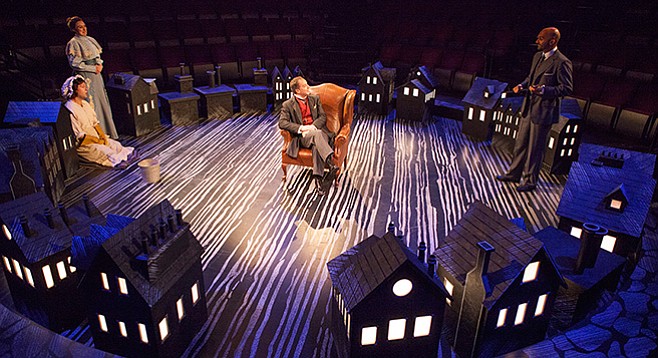 Facebook
Facebook
 X
X
 Instagram
Instagram
 TikTok
TikTok
 Youtube
Youtube

How to characterize Ken Ludwig’s take on Sir Arthur Conan Doyle’s famous mystery? It’s not an all-out spoof, since it wades through pages and pages of exposition about the monster hound haunting the moors of Devonshire. And, given Ludwig’s blazing track record, it isn’t all that campy, at least under Josh Rhodes’ direction and the Old Globe’s technical wizardry. Camp often implies cheap effects; these star the show. So, a serious send-up?
This helps explain why the production hops between funny bits and long, talky stretches that deflate the suspense. It’s not about solving the mystery or exploring the incisive mind of Sherlock Holmes: it’s about three actors having to play dozens of characters, and a technical team having to reinvent Rubik’s Cube on the spot.
Euan Morton, who doesn’t appear often, gives Holmes little spark (because his seriousness would undercut the silliness?). Usman Ally’s Dr. Watson’s a nice blend of competence and toe-tripping. Andrew Kober, Blake Segal, and Liz Wisan play the rest: Dr. Mortimer, the Stapleton’s, Mr. & Mrs. Barrymore, Laura “L.L.” Lyons, Mr. Frankland, three Baskervilles, etc. They stroll off-stage (the director giving each a memorable exit), then return, sometimes in seconds, as someone else: a completely new costume, new facial expression, new accent, even new gender.
At one point Liz Wisan comes back on stage maybe a half second late: different outfit, different wig, but all perfectly in place, as if she’d spent hours before a dressing room mirror. Asked where she’s been, she replies, “you have no idea,” and gets one of the evening’s biggest laughs.
It’s appropriate that the show’s three dressers, all in black with headsets and Madonna mikes, take a well-earned bow at the curtain call.
The designers should too. In Close Encounters of the Third Kind, when the organist can’t keep up with the mother ship’s musical vocabulary, the computer takes over. Austin R. Smith’s lighting cues for Baskerville suggest the same need. They’re in near constant motion, shaping the stage, flickering, strobing, murking the moors with lowered lamps, crystal chandeliering (at least nine), and searchlighting the gallery of Baskerville oil portraits on the walls of Wilson Chin’s set, where top hats drop from the sky, canes pop up, mini-trains chug white smoke, and little black houses circle the arena stage, their steep Victorian roofs doubling as tables and hideaways for props.
Shirley Pierson’s period-precise costumes and Bart Fasbender’s original music and creepy, at times stereophonic sounds turn the White Theater into a two-act magic show.
How could they? What will they do next? The effects, the stopwatch timing, and the backstage experiment in Chaos Theory are so impressive they become a tour de force that, in the end, converts the fun, though often silly and at times tedious piece, from a Who- to a How-dunnit.


How to characterize Ken Ludwig’s take on Sir Arthur Conan Doyle’s famous mystery? It’s not an all-out spoof, since it wades through pages and pages of exposition about the monster hound haunting the moors of Devonshire. And, given Ludwig’s blazing track record, it isn’t all that campy, at least under Josh Rhodes’ direction and the Old Globe’s technical wizardry. Camp often implies cheap effects; these star the show. So, a serious send-up?
This helps explain why the production hops between funny bits and long, talky stretches that deflate the suspense. It’s not about solving the mystery or exploring the incisive mind of Sherlock Holmes: it’s about three actors having to play dozens of characters, and a technical team having to reinvent Rubik’s Cube on the spot.
Euan Morton, who doesn’t appear often, gives Holmes little spark (because his seriousness would undercut the silliness?). Usman Ally’s Dr. Watson’s a nice blend of competence and toe-tripping. Andrew Kober, Blake Segal, and Liz Wisan play the rest: Dr. Mortimer, the Stapleton’s, Mr. & Mrs. Barrymore, Laura “L.L.” Lyons, Mr. Frankland, three Baskervilles, etc. They stroll off-stage (the director giving each a memorable exit), then return, sometimes in seconds, as someone else: a completely new costume, new facial expression, new accent, even new gender.
At one point Liz Wisan comes back on stage maybe a half second late: different outfit, different wig, but all perfectly in place, as if she’d spent hours before a dressing room mirror. Asked where she’s been, she replies, “you have no idea,” and gets one of the evening’s biggest laughs.
It’s appropriate that the show’s three dressers, all in black with headsets and Madonna mikes, take a well-earned bow at the curtain call.
The designers should too. In Close Encounters of the Third Kind, when the organist can’t keep up with the mother ship’s musical vocabulary, the computer takes over. Austin R. Smith’s lighting cues for Baskerville suggest the same need. They’re in near constant motion, shaping the stage, flickering, strobing, murking the moors with lowered lamps, crystal chandeliering (at least nine), and searchlighting the gallery of Baskerville oil portraits on the walls of Wilson Chin’s set, where top hats drop from the sky, canes pop up, mini-trains chug white smoke, and little black houses circle the arena stage, their steep Victorian roofs doubling as tables and hideaways for props.
Shirley Pierson’s period-precise costumes and Bart Fasbender’s original music and creepy, at times stereophonic sounds turn the White Theater into a two-act magic show.
How could they? What will they do next? The effects, the stopwatch timing, and the backstage experiment in Chaos Theory are so impressive they become a tour de force that, in the end, converts the fun, though often silly and at times tedious piece, from a Who- to a How-dunnit.
Comments